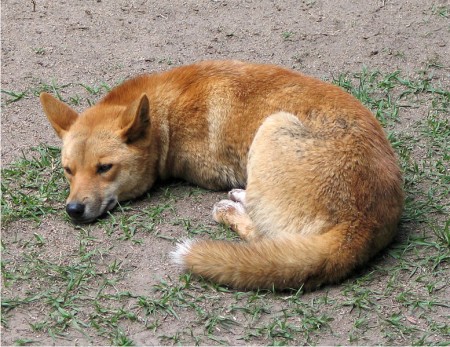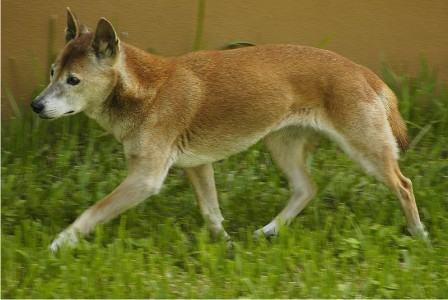| Genetics
Origin of the Australian Dingo
as revealed
by the study of Mitochondrial DNA
Summary by Dr.
Dominique
de Caprona
© de Caprona
2009

Australian Dingo,
Canis
lupus dingo © Jörn Brauns
The study
entitled "A
Detailed picture of the origin of the Australian Dingo, obtained from
the
study of Mitochondrial DNA" by Savolainen et al (2004) gives
insight
as to when and from where the Australian Dingo* may have originated.
Mitochondrial
DNA
A) 582 bp of
the
mtDNA control region were analysed in:
211 Dingoes
from Australia,
19 kept in captivity and 192 from the wild representing 27 regions
across
the country.
676 dogs from
Europe, Africa,
Southwest Asia, India, Siberia, Arctic America, China/Mongolia/Korea,
Japan,
Vietnam/Cambodia/Thailand, Indonesia, Malaysia, Philippines, Highland
New
Guinea.
38 Eurasian wolves
B) 290 bp of
the
mtDNA were analysed in pre-European archaelogical dog remains from Cook
Island, Hawai and New Zealand.
Results
The mtDNA of the
Australian
Dingo shows restricted sequence variation compared to the domestic dogs
and the wolves in the study.
The 211 Dingoes had
20 mtDNA
types differing from each other by at most 2 substitutions. 2 of the
Dingo
mtDNA types were identical to dog haplotypes, whereas the other 18 were
specific to Dingoes.
In contrast, the 676
domestic
dogs showed 114 mtDNA types with up to 16 substitutions between mtDNA
types.
All mtDNA
sequences among
Dingoes fall within the largest clade of dog sequences, Clade A,
representing
70% of domestic dog types.
53% of the
Dingoes had
the A 29 mtDNA type, one had the A 9 type, and 18 had mtDNA types
unique
to Dingo clustering around A 29 in a star-like formation,
indicating
that all Dingo mtDNA types originate from A 29. A9 was found only
in
one indivdual and is considered to be the result of a parallel mutation.
The mean distance to
A 29
in the Dingo mtDNA sequences shows considerable variation between
Western
Australia and other areas of the country, probably as a result of
random
genetic drift.
The A 29 type is
found in
domestic dogs also but only in East Asia and Arctic America.
Conclusions
The authors conclude
that
the Australian Dingo originates from East Asia, not from India, and
that
it perhaps travelled to Australia during the Austronesian expansion
into
Island Southeast Asia. They descend from a small population of dogs,
theoretically
as few as single pregnant female or as a small group which had lost
genetic
variation on its way from the Asian Mainland, and have evolved until
today
in isolation from other canine populations. The mean genetic distance
between
the Dingo's mtDNA sequences times the origin of the Dingo at circa
4,600
to 5,400 years ago. The dogs of neighboring islands as well as the
archaeological
samples show that several other mtDNA types were present in the region.
The fact that none of them were found in the Dingoes suggest that their
ancestors were imported only once.
Interestingly, the
feral
New Guinea** Singing Dog (Canis lupus hallstromi) also has the mtDNA A
29 type, and a unique New Guinea Singing dog type derived from A 29 by
one substitution. It is therefore possible that it shares a common
origin
and had some gene flow with the Australian Dingo.

New Guinea Singing
Dog,
Canis lupus hallstromi © Valerie Abbott
Acknowledgements
I thank P.
Savolainen for
fine tuning this text.
References
Savolainen P,
Leitner
Th, Wilton AN, Matisoo-Smith E, Lundeberg J (2004): "A
Detailed
picture of the origin of the Australian Dingo, obtained from the study
of Mitochondrial DNA". PNAS, August 17 2004, Vol.101, no33,
pp12387-12390
Author's note:
*The Aborigenes
highly valued
the Dingo as a hunting companion and as a guard dog although the Dingo
was not fully domesticated. The Dingoes also kept them warm at night.
In
many areas the Dingo is now wild and lives alone or in small
territorial
groups. The Dingo howls and yelps but does not bark. Its preservation
is
threatened as it loses habitat, crossbreeds with dogs and is considered
in some areas to be a pest.
**New Guinea is
the world's
second largest island situated North of Australia. It is separated in
two
roughly identical political halves, West Papua with Manokwari as its
capital,
and Papua with Jayapura as its capital.
ABOUT
THE AUTHOR
|

